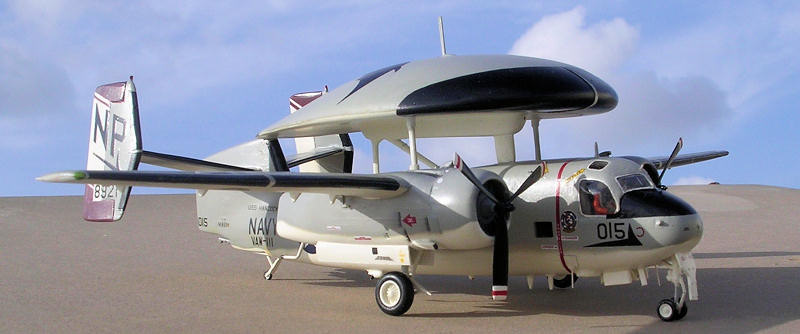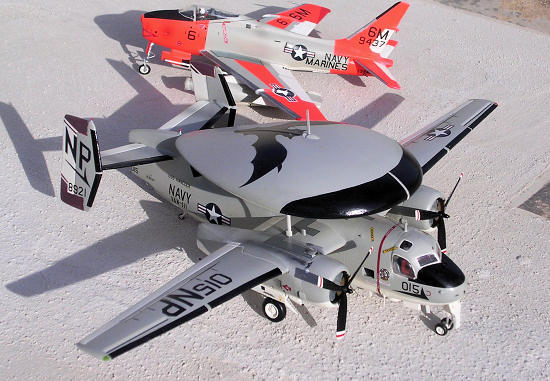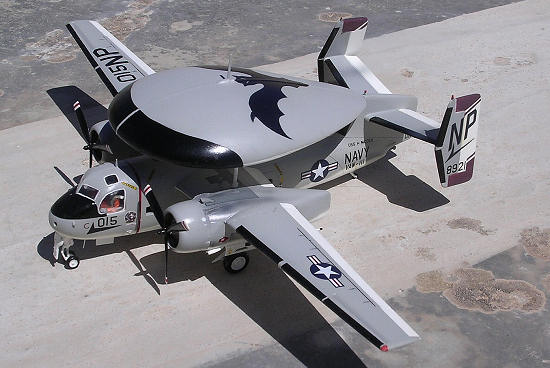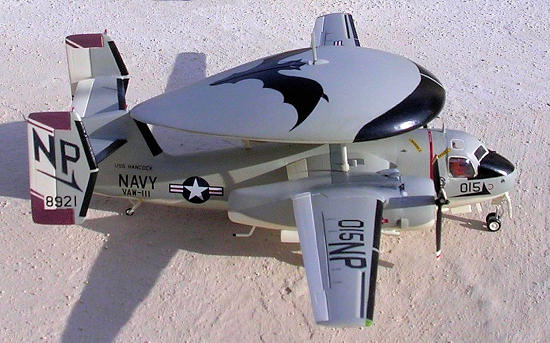
RVHP 1/72 E-1B Tracer
| KIT #: | 7243 |
| PRICE: | $ |
| DECALS: | options |
| REVIEWER: | Carmel J. Attard |
| NOTES: | Resin short run conversion kit complete with instructions, scale plans and no decals. |

| HISTORY |
The Tracer was
a carrier Airborne Early Warning aircraft manufactured by Grumman. First flight
took place on 17the December 1956 and went into service with the US Navy in
1958. When the E-1B joined the fleet during early 1961, it soon replaced the
remaining Douglas AD-5W Skyraiders as the standard shipboard AEW aircraft. The
E-1B was also used in sea search crew training role. 88 in number Tracers were
built. The type was retired from service in 1977 when it was replaced by the
more modern E-2 Hawkeye,
 The E-1 was
designated WFunder the old US Navy system; the designation earned it the
nickname "Willy Fudd". Since the S-2 Tracker was known as S2F under the old
system, that airplane was nicknamed "Stoof"; the WF/E-1 with its distinctive
radome gained the nickname "Stoof with a Roof." The E-1 featured folding wings
for compact storage aboard aircraft carriers. Unlike the S-2 and C-1 in which
the wings folded upwards, the radome atop the fuselage necessitated the E-1 to
fold its wings along the sides of the fuselage.
The E-1 was
designated WFunder the old US Navy system; the designation earned it the
nickname "Willy Fudd". Since the S-2 Tracker was known as S2F under the old
system, that airplane was nicknamed "Stoof"; the WF/E-1 with its distinctive
radome gained the nickname "Stoof with a Roof." The E-1 featured folding wings
for compact storage aboard aircraft carriers. Unlike the S-2 and C-1 in which
the wings folded upwards, the radome atop the fuselage necessitated the E-1 to
fold its wings along the sides of the fuselage.
The Tracer was
fitted with the Hazeltine AN/
XTF-1W/XWF-1
aerodynamic
prototype (BuNo 136792) without electronics, later rebuilt as a standard C-1A,
retaining the twin tail.
WF-2
Airborne Early
Warning version of the TF-1 Trader redesignated E-1B in 1962, 88 built.
WF-2
redesignated in 1962.
Also known as E-1B Tracer it carries
a crew of 4, two pilots and two Radar /Intercept Controllers. It is powered by
2x Wright R-1820-82A Cyclone 9-cylinder radial
 piston engine, 1,525 hp
take off
power each. Giving a maximum speed of 283mph at 4,000ft
and a cruising speed of 163 mph and a range of 1,035 miles. An endurance
of 4.63 hours on station at 150 nm1 at 5,000 ft.
piston engine, 1,525 hp
take off
power each. Giving a maximum speed of 283mph at 4,000ft
and a cruising speed of 163 mph and a range of 1,035 miles. An endurance
of 4.63 hours on station at 150 nm1 at 5,000 ft.
When the E-1 Tracers were withdrawn
from service 48 were sold to Consolidated Aeronautics in Tucson. Although all
have suffered spare parts reclamation, they were offered for sale as
potentially flyable. The Tracer were replaced by the E-2 Hawkeye.
| THE KIT |
The kit of the E-1B Tracer was released by RVHP some years ago and was a vacuum cast Polyurethane resin conversion set for the Hasegawa/Hobbycraft Grumman S-2A. The cream colored resin consisted of a 2 part radome, two outer fin and rudders. A two part main fuselage with the cockpit area have empty space to provide for the crew office seat and instrument arrangement and which was made in such a way so that the clear Hasegawa kit parts fit with little of effort. Two engine nacelle rear parts are also provided which complete the set.
| CONSTRUCTION |
 Using the drawings provided as a
guide to parts location, each part was first cleaned from any excess resin
located at the periphery of parts. Heavy resin runner was carefully parted using
a fine saw. In doing so a face mask was worn as the fine powder emanating from
the cutting can be a health hazard if ingested or inhaled.
The Tracker (Hasegawa kit) to Tracer conversion entails a new fuselage,
tail section, rear engine nacelles and adding a radome. When all the components
were all prepared for assembly , the main radome supports were made out of thick
plastic card. The kit also contained a steel strip (extruded metal struts) in
case it can be used for same radome supports. These were measured and fixed to
upper wing decking. The secondary support stay location were marked on the
radome low surface.
Using the drawings provided as a
guide to parts location, each part was first cleaned from any excess resin
located at the periphery of parts. Heavy resin runner was carefully parted using
a fine saw. In doing so a face mask was worn as the fine powder emanating from
the cutting can be a health hazard if ingested or inhaled.
The Tracker (Hasegawa kit) to Tracer conversion entails a new fuselage,
tail section, rear engine nacelles and adding a radome. When all the components
were all prepared for assembly , the main radome supports were made out of thick
plastic card. The kit also contained a steel strip (extruded metal struts) in
case it can be used for same radome supports. These were measured and fixed to
upper wing decking. The secondary support stay location were marked on the
radome low surface.
Turning to the wings, the folding
lines on the Hasegawa kit were filed flush and new ones were scribed using a
pointed scribing too. The wing parts were assembled according to the
instructions and the search light fairing on the leading edge was filed flush.
The Hasegawa engine nacelles were cut off at the vertical panel lines in line
with the rear of the wheel wells and in place fitted the new conversion parts
using super glue to join the parts together. The fuselage and wings were
assembled. As the radome was going to offset the weight to result into a tail
sitter I added lead pieces weight to the nose area. The horizontal tailplanes
were then fitted and these were matched to vertical at right angle. A new radome
antenna was made from plastic card. When all the assembly was in one piece the
huge radome was brought to the fuselage. To simplify matters I made a dowel pin
to the radome struts which inserted into a precisely measured locating drilled
hole and this saved the day as the radome simply glued at the correct spots.
Reference to photos indicated the
location of the single wireless that joins the tail plane to fuselage.
| COLORS & MARKINGS |
 The underside of the radome was
airbrushed in semi gloss white
before assembled on top of the fuselage. This was then joined to fuselage and
the underside of the assembly was given coats of same Model Master white. With
the undersides masked the rest of upper fuselage and wing areas were airbrushed
in gull grey FS 36440. A coat of Johnsons Klear prepared the kit to receive the
decals.
The underside of the radome was
airbrushed in semi gloss white
before assembled on top of the fuselage. This was then joined to fuselage and
the underside of the assembly was given coats of same Model Master white. With
the undersides masked the rest of upper fuselage and wing areas were airbrushed
in gull grey FS 36440. A coat of Johnsons Klear prepared the kit to receive the
decals.
After making drawings for the correct size of decals that I was planning to apply to the Tracer I sent these to Phillip Weston of Auckland, New Zealand who made for me a perfect set of decals for which I am thankful. These were applied to the kit and the finally the Tracer model was given a coat of semi gloss clear MM varnish.
| CONCLUSIONS |
This was my second kit of the Tracer
AKA Willy Fudd and was more a straight forward one since the conversion parts
were readily available to me when compared
to my previous build where the parts
were curved out of wood..
Overall this is a very nice
conversion kit which I thoroughly enjoyed building. Iíll be looking out for
more conversion products from this manufacturer in the future.
| REFERENCES |
 Wikipedia.com
Wikipedia.com
November 2010
If you would like your product reviewed fairly and quickly, please contact me or see other details in the Note to Contributors.